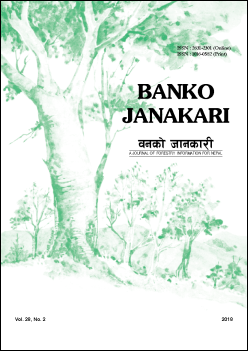Anatomy of two Rhododendron species along the elevational gradient, Eastern Nepal
DOI:
https://doi.org/10.3126/banko.v28i2.24186Keywords:
Adaptation, ecological anatomy, elevation, Nepal, RhododendronAbstract
A wide range of habitat conditions including elevation determine adaptative variation in a species. The study was carried out to investigate the anatomical variation of two common species of Rhododendron (R. anthopogon and R. lepidotum) growing between 3200 and 4700 m asl in Gokyo valley of Sagarmatha National Park, Khumbu, eastern Nepal. Seven anatomical characters viz. pore area (PA), pore density (PD), vessel element length (VEL), fiber tracheid length (FL), ray density (RD), uniseriate ray height (URH) and uniseriate ray cell number (URCN) of twenty-three samples for two species (12 samples of R. anthopogon and 11 of R. lepidotum) were studied by making permanent slides of transverse, tangential longitudinal and radial longitudinal stem sections. In R. anthopogon, out of three non- anatomical characters (plant height, soil nitrogen and leaf nitrogen) the nitrogen content in leaf increased with increasing elevation. However, the plant height and nitrogen content in soil did not vary significantly with elevation. Out of the seven wood anatomical characters three characters such as PA, VEL and FL decreased with increasing elevation. The other four characters, PD, RD, URH and URCN did not vary significantly with elevation. In R. lepidotum, plant height decreased with increasing elevation and nitrogen content of soil and leaf increased with elevation. The PD, PA, VEL and FL decreased along the elevation gradient. However, RD, URH and URCN did not vary significantly with elevation. These variations in the anatomical features of both species have been attributed to the adaptative strategies of the plant in the hostile environment at high elevation.
Downloads
Downloads
Published
How to Cite
Issue
Section
License
© Forest Research and Training Centre, Ministry of Forests and Environment, Nepal




